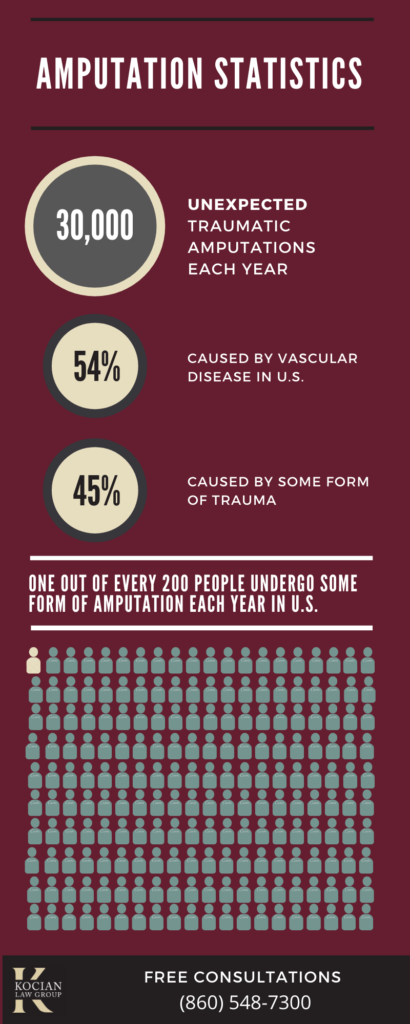Common Amputation Injury Causes

Amputation occurs when a limb or other part of the body is cut off, either from surgery or some type of accident. There are two amputation types: intentional and unintentional. Intentional amputation is the result of an infection or severe condition that requires removal of the body part affected. Unintentional amputation happens when a car crash, job-related accident, or defective machine severs a part of the body.
Undergoing an amputation is devastating. Learning to live without a vital part of the body is overwhelming for anyone. You suddenly need to find a new way to perform routine tasks and participate in activities you once enjoyed.
The new life you’re facing is a period of adjustment and adaptation. You might have to hire a caretaker, undergo painful medical procedures, or use a prosthetic for the rest of your life. Those kinds of changes cause physical and emotional damage that negatively impacts your job, relationships, and overall happiness.
Types of Accidents that Result in Amputation Injury
The events or circumstances leading to an amputation can vary dramatically. Any severe accident could result in a loss of limb. Cases of medical malpractice also arise and necessitate the need to amputate the damaged body part. Amputations involve a limb or extremity, such as fingers, arms, legs, toes, and ears. Losing any body part is a traumatic experience.
Types of Accidents that Result in Amputation Injury
- Road accidents: Individuals traveling in cars, bicycles, motorcycles, and trains could fall victim to limb amputation. A pedestrian hit by a vehicle could also sustain an amputation injury.
- Workplace accidents: Employees on construction sites suffer the most amputation types of injuries. Additionally, industries where workers handle heavy machinery or perform tasks at great heights, are at risk.
- Agricultural accidents: Workers in this industry often work with or near equipment and heavy machinery that, if defective or used improperly, could cause an amputation accident.
- Firearms and explosives: Military members or people using fireworks and other explosives could suffer from an accident amputation
- Electrocution accidents: Anyone handling electrical wires could end up needing amputation of the fingers, hands, or other body parts.
Amputation causes are typically divided into two different categories: surgical and traumatic. With a surgical amputation, removing a body part is necessary because of the injuries sustained. Traumatic amputations occur during the actual incident.
Depending on the section of your body getting amputated, it’s referred to as a lower-limb amputation or upper-limb amputation.
Complications from Amputations
Whether you suffered a limb amputation because of a catastrophic accident or from a necessary surgery, complications could arise. The permanent disability it causes creates the need for medical treatment and rehabilitation.
The success of any rehab program depends on the following factors:
• Type and level of the amputation
• Degree of impairment or disability that resulted
• The individual’s general health
• Available family support
Whether it’s a car accident amputation or surgeon error, participating in rehab is useful in reaching your physical and emotional goals. Treatments, such as wound care, exercises to promote muscle strength, and pain management, all aid in recovery.
If you’re undergoing an emergency amputation, your doctor will perform a full assessment to determine the amputation types most suitable for your situation. However, in cases like a motorcycle accident leg amputation, there’s no time for a doctor to check for possible adverse effects.
Despite the necessary precautions you take to care for your loss of limb, there’s a risk of complications, ranging from manageable to life-threatening.
The most common amputation complications include:
• DVT (deep vein thrombosis)
• Heart problems, such as a heart attack
• Pneumonia
• Slow healing or infection
• “Phantom limb” pain
In some instances, it’s necessary to undergo another surgery to relieve your pain or correct any issues. When it comes to other complications, medicine or physical therapy could help. To avoid any possible problems, you must follow your doctor’s instructions.
To prevent infection, nerve damage, or other difficulties, you should take the following precautions:
• Attend all scheduled rehabilitation sessions
• Wash the affected body part until wounds heal
• Don’t wear clothes that restrict blood flow to any remaining portion of the amputated limb
• Use a compression garment to help any swelling that occurs
• If necessary, get a wheelchair and make sure your home is wheelchair-accessible

Should I Sue for Amputation Injury?
If someone else’s negligence caused you to lose a limb, you could file a loss of limb lawsuit. Negligence is when an individual lacks reasonable care to prevent injury to another. Whether negligence leading to your injury existed in a car accident, medical malpractice, premise liability, or product liability case, you could potentially seek compensation.
You need to make sure the statute of limitations hasn’t run out yet if you are pursuing a personal injury lawsuit. A statute of limitations is the time limit placed on a person to bring legal action against another individual or entity. The statute of limitations for personal injury cases in Connecticut is two years. That means you have only two years from the date of the incident to file an amputation lawsuit. If two years pass, you lose your right to seek compensation from that specific individual or entity for that particular event.
Proving liability is an integral part of suing anyone for negligence. You must provide sufficient evidence that the other party caused the accident or situation that led to your limb amputation.
Essential evidence you should obtain for your amputation injury case includes:
• Police or incident reports
• Witness statements
• Photos
• Video surveillance
• Your medical records
Due to the severity of your situation, you could receive more money from an amputation lawsuit than an insurance claim. However, preparing for trial requires much more documentation, witnesses, and testimony than merely filing a personal injury claim. An amputation lawyer could help you gain an understanding of both choices and decide which is better for you.
Damages in Amputation Injury Claims
Damages are losses the victim of an accident incurred due to their injury. In Connecticut, you could receive compensation for both economic and noneconomic damages. Economic damages are actual costs, while noneconomic damages are physical pain or mental distress.
You could seek compensation for some or all damages by filing an insurance claim or loss of limb lawsuit.
The damages available in personal injury cases are the following:
- Medical expenses: Treatment and care after your accident amputation, such as rehabilitation, home health care, prosthetic fitting, and surgery.
- Mental distress and suffering: Emotional or psychological trauma that resulted from the loss of the limb, such as depression or anxiety.
- Physical pain and suffering: Significant physical pain experienced due to the extent of your injury.
- Lost Wages: Pay you couldn’t earn because the accident caused you to take time off from work.
- Disfigurement: Impairment that negatively affects your perceived beauty, appearance, or symmetry.
- Permanent impairment or loss of function: A permanent disability, such as decreased range of motion or failure of a vital organ.
- Loss of enjoyment of life: The unfavorable impact of the amputation on your ability to perform activities you used to enjoy.
- Loss of Consortium: An individual’s right to seek compensation for the loss of the relationship with the victim that existed before the accident.
- Death: If someone dies as a result of their amputation accident, an immediate family member could file a claim for benefits, such as funeral costs.
The settlement you receive is dependent on six key factors:
- The severity of the amputation injury
- The negative impact of the accident on your life
- The type of treatment required
- The apparent existence of liability
- Any emotional trauma experienced
- Any future treatment or costs necessary
How Kocian Law Group Can Help Me
The loss of a limb will entirely alter the course of your life. It comes with both physical and emotional challenges that must be recognized and dealt with. Our team of compassionate and aggressive injury attorneys will be here to support you, and we’ll work to get you the justice and fair compensation you deserve.
We represent clients on a contingency fee basis, which means we won’t charge you anything until we secure compensation for you. We also provide a free consultation to all prospective clients. There’s no risk or obligation to speak with our lawyer for amputation injury and discuss the options available to you.
We have four conveniently located offices throughout Connecticut and one in New York City. Call us at (800) 300-2989 today, and we’ll schedule your free consultation.






